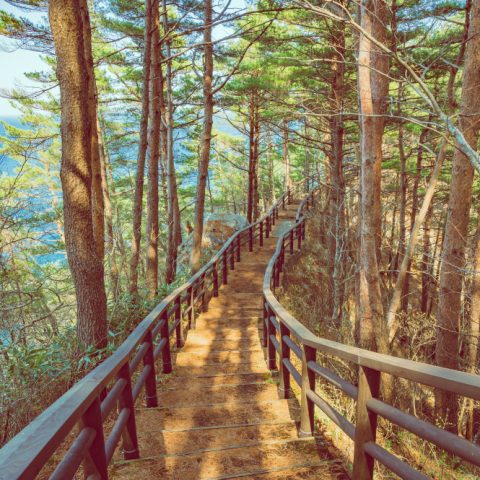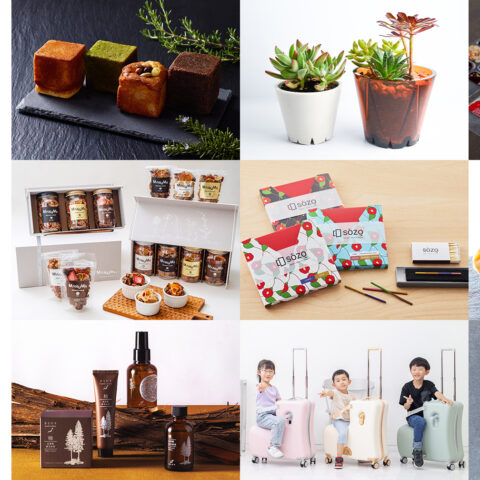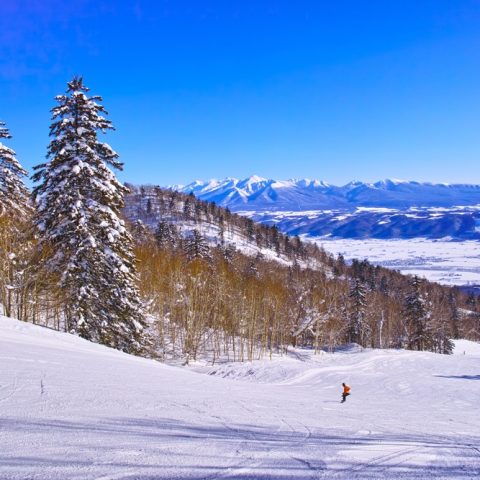
Japan is a beautiful country full of tradition and culture, but with so many things to see and explore, planning your next trip might be a little overwhelming! That’s why we’ve prepared the ultimate bucket list! It includes a must-see and a must-eat for all 47 Japanese Prefectures so you can discover Japan step by step and bite by bite.
In this section, we will explore the northernmost regions of the country where stunning scenery, delicious fresh seafood, and old traditions await you!
HOKKAIDO
HOKKAIDO: THE BREATHTAKING NORTHERNMOST JAPANESE ISLAND

- To see: Blue Pond (Aoi-Ike)
Located in the city of Biei, the Blue Pond has become popular among tourists and it’s easy to understand why! This amazing pond changes its color based on the season, shifting from a light blue to a deep turquoise with gorgeous green shades. The color of the water also changes if the wind blows and if it’s a cloudy, rainy or sunny day. This magical pond can truly be enjoyed in every season and weather condition!

- To eat: Kani
Hokkaido is famous for the amazing quality of seafood, and crabs (kani in Japanese) are definitely a must-try if you are visiting this prefecture. With so many local varieties to choose from, kani can be found in several traditional dishes: boiled, with rice, in soups, kani miso, and the list goes on. Every part of this crustacean is eaten in a particular way! And if you really love crabs, make sure to try one of the many restaurants offering an all-you-can-eat deal on kani legs.
TOHOKU
AOMORI: LIVELY FESTIVALS AND DELICIOUS SEAFOOD

- To see: Nebuta Warasse
Nebuta Matsuri is one of the biggest and most beloved summer festivals held in Japan. Thanks to the Nebuta Warasse Museum, you can enjoy this amazing matsuri year-round. The museum’s interiors recreate the lively atmosphere of the festival and allow visitors to retrace its 300-year long history through images, photographs and historical items. Moreover, visitors can admire four of the incredible parade floats that were used in the previous years festival.

- To eat: Nokkedon
A must eat in Aomori is definitely the nokkedon, especially while visiting the Furukawa Fish Market. A nokkedon is basically a do-it-yourself donburi (fish, meat or vegetables served over steamed rice). Just purchase tickets (sold in sets of five or ten), and stroll around the market until you find the perfect toppings for your own personal nokkedon!
AKITA: DIVE DEEP IN SAMURAI HISTORY

- To see: Samurai District
Akita prefecture has a rich history connected with the samurai period. The Samurai District, located in the small city of Kakunodate, is one of the best places to experience the old samurai culture and architecture. Here you can visit old samurai houses that date back 350 years. The city was divided into two parts: the North, where the samurai lived, and the South, which was intended for traders. Some shops are still open to this day, like Ando Jozo, an old soy sauce brewery selling products that use the same traditional techniques handed down through generations. It truly seems that time has stopped in Kakunodate!

- To eat: Kiritanpo
Kiritanpo is Akita’s most famous local delicacy. It is prepared by beating freshly cooked rice until it becomes a sort of puree, then rolling it into cylinders and toasting it on the fire. Kiritanpo is usually enjoyed directly from skewers and eaten with a sweet soy sauce, or in nabe (a Japanese hot pot) along with meat and vegetables.
IWATE: HEAVENLY BEACHES AND TRADITIONAL FOOD CHALLENGES

- To see: Jodogahama Beach
Its name means “Beach of the Pure Land” due to its idyllic scenery that recalls the Buddhist paradise, the Pure Land. Therefore, It is no coincidence that it is considered the most beautiful beach on the Sanriku Coast. In addition to the beautiful white sand, this beach is framed by stunning white rocks, green pine forests, and crystalline blue waters offering spectacular scenery that is listed among the top 100 most beautiful beaches in Japan.

- To eat: Wanko Soba
Wanko soba is Iwate’s own food challenge: eat as many dishes of Wanko soba as you can! This typical dish is eaten like this: buckwheat noodles are served in small bowls that are filled an unlimited number of times until you put the lid on the bowls to indicate that you are full. The origins of Wanko soba date back 400 years and each restaurant has its own peculiar challenge, rituals, and entertainment before and after the meal. Some restaurants even hand out a small prize to diners such as a plaque with the number of bowls eaten!
YAMAGATA: BETWEEN CULINARY TRADITION AND INNOVATION

- To see: Kamo Aquarium
Ready to visit an aquarium that holds a record in the Guinness World Record Book? The Kamo Aquarium gained the prize for being home to the largest number of jellyfish in the world! With more than 35 species exhibited in beautiful tanks, Kamo Aquarium will surely mesmerize you. For the more adventurous, visitors can even eat them! Fished daily from the sea, fresh jellyfish are the staple ingredient for a wide range of dishes, such as ramen and even ice cream and cookies.

- To eat: Imoni
Don’t feel like having jellyfish ice cream? Fear not, Yamagata offers other delicious local delicacies. Among the many traditional dishes, imoni is definitely a must-eat. Imoni is a meat and vegetable stew prepared with thin slices of beef, taro root, konnyaku (flour obtained from the konjac tuber), spring onion and various seasonal ingredients cooked slowly in a sweetened soy sauce broth inside of a big cast iron kettle.
MIYAGI: CATS AND SWEETS, WHAT A LIFE!

- To see: Cat Island (Tashirojima)
If you love cats, then Miyagi Prefecture has the perfect island for you! In the tiny island of Tashirojima, there is a feline community of more than 800 cats. Thanks to this bizarre characteristic, the island is also known as “Cat Island”. The number of cats is much higher than that of the few fishermen who live here. In addition to petting cute cats, the island has easy hiking trails, funny cat-shaped architecture, and breathtaking ocean views. Lastly, according to popular belief, visiting the cat sanctuary will even bring good luck!

- To eat: Zunda Mochi
Bright green in color, zunda mochi is a simple yet delicious dessert made of plain mochi and garnished with sweet edamame paste (zunda). Recently, almost all sweets that use red bean paste can be found with zunda in Miyagi Prefecture, such as dorayaki or taiyaki. You can also try this edamame paste in the popular zunda milkshake!
FUKUSHIMA: WALK AROUND OLD JAPAN AND EAT WITH PECULIAR CUTLERY

- To see: Ouchi-juku
Take a step back in time in the beautiful village of Ouchi-jiku, where everything has remained exactly as it was during the Edo period. Along with the timeless charm of Ouchi-jiku, the surrounding environment characterized by beautiful mountain scenery helps to make the atmosphere even more picturesque in every season. Nowadays, inside the characteristic thatched-roof houses, there are restaurants and shops where you can enjoy local specialties and purchase traditional souvenirs.

- To eat: Negi Soba
Fukushima Prefecture has a long culinary tradition with soba, delicious buckwheat noodles that can be enjoyed both hot and cold. One of the most peculiar variations can be found in Ouchi-juku. It’s called negi soba. These soba noodles get their name from the fact that instead of eating them with regular chopsticks, you eat the soba with a leek (negi in Japanese)! Using a leek helps enhance the soba’s flavor, and some say that it can even bring good luck.
Did you like our recommendations? Stay tuned for the next section of our bucket list, where we will discover more about the regions of Kanto and Chubu!




